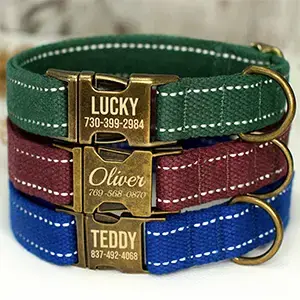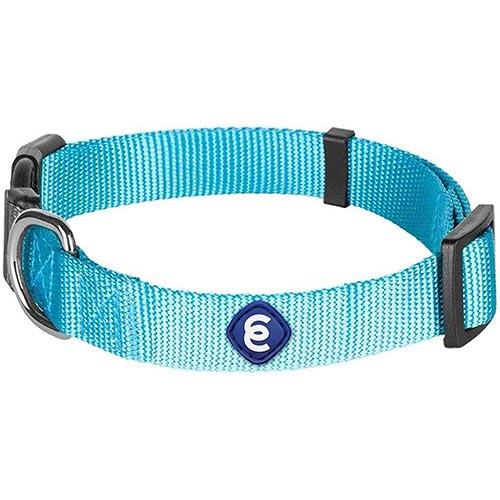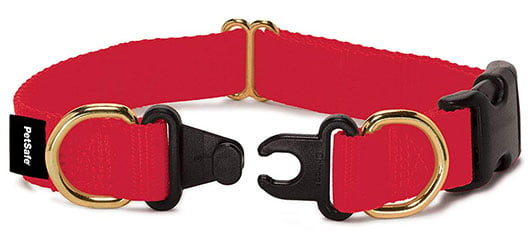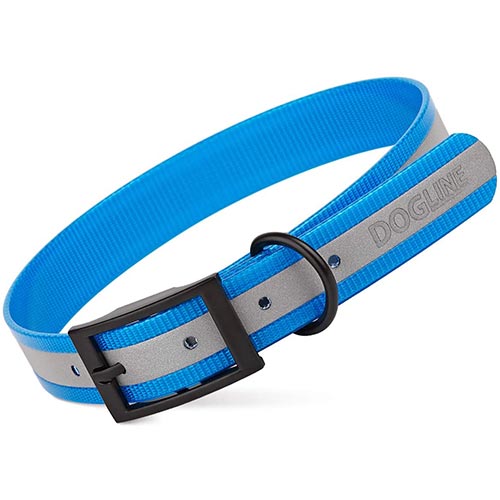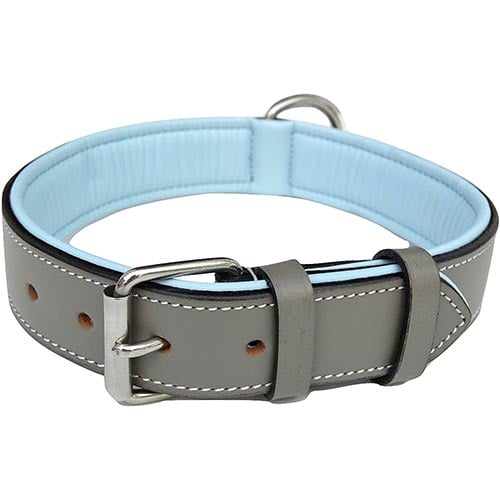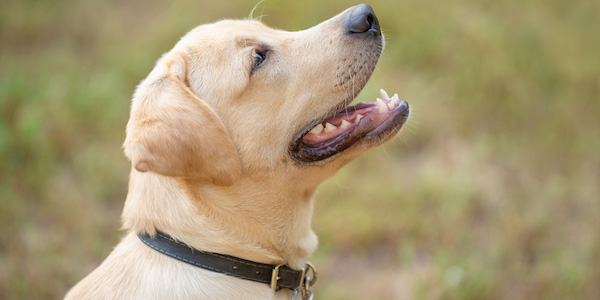 Finding a dog collar for your dog might not seem difficult — until you walk into the pet store and find an entire aisle dedicated to all the different types, styles, and uses!
Finding a dog collar for your dog might not seem difficult — until you walk into the pet store and find an entire aisle dedicated to all the different types, styles, and uses!
For some, a collar is simply a place to hang their dog's ID tags; for others, it's the only gear their pup wears while out on leashed walks.
Some collars are advertised to help stop leash pulling, and others are simply all about being fashionable.
Let's look at the types of collars available and what type is the best choice for you and your dog, depending on your needs.
Should You Walk Your Dog on a Collar or a Harness?
Before we dive into collar types, a quick word on whether walking your dog with the leash attached to a flat collar is okay. While it's not my preferred choice, walking your dog on a collar is fine as long as they are rockstars with loose leash walking.
I see plenty of dogs with great leash manners walking with the leash attached to their collar rather than a harness.
However, if your dog pulls on a leash or knows how to back out of their collar to escape it, you shouldn't use their collar for leashed walks.
Tips for Choosing a Dog Collar
Dog Collar Types
How to Fit Your Dog's Collar
Introducing Wearing a Collar
Should Your Dog Wear a Collar Inside?
The potential for injuries from the use of aversive dog collars, such as prong and choke collars, has been well documented.
But even flat collars can cause injuries to your dog's neck, trachea, front leg nerves, eyes, ears, and even thyroid.
Your dog might see a squirrel and run after it, jerking their neck when they hit the end of the leash.
Dogs who pull like freight trains are putting constant pressure on their trachea, choking themselves in their effort to go go go!
And unfortunately, a common response to a pulling dog is to jerk or pop the leash to correct them.
This pressure on the neck can cause injury at the moment or cause health issues over time.
NOTE: Since Brachycephalic (flat-faced) breeds often have difficulty breathing and narrow tracheas, it is better to use a harness to walk them. Any risk of potential trauma to the trachea due to direct trauma or trauma to the surrounding muscles from pulling can be potentially life-threatening for these dogs.
If your dog has any of the following medical conditions, it’s best to opt for a harness instead of a collar when going for a walk. These conditions can be caused and/or exacerbated by pulling on the collar.
- Laryngeal Paralysis
- Collapsing trachea — common, especially in small terrier dogs, like Yorkshire Terriers.
- Kennel cough — more correctly called “Infectious Tracheobronchitis,” where the “itis” means there is inflammation, and therefore increased sensitivity, of your dog’s trachea (which a pulled-upon collar will put additional pressure on).
- Slipped disc, arthritis, or other cause of neck pain.
- Horner’s Syndrome — if the nerve damage causing your dog’s Horner’s Syndrome symptoms is from the portion of the nerve pathway in their neck, avoiding the use of a neck collar is important.
- Canine Wobbler Syndrome — a neurological problem affecting the spine in the neck region, typically of larger breed dogs. “Wobblers” manifests as an abnormal walking pattern.
If “Wobblers” is suspected or diagnosed, a neck collar should definitely be avoided. (More about Wobbler Syndrome from our friends at The Ohio State University College of Veterinary Medicine). - Surgery in the neck region
- Thyroid or salivary gland issues
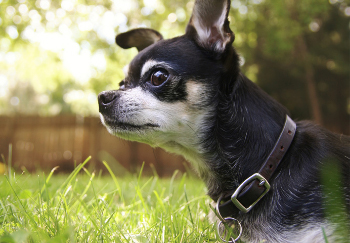 Tips for Choosing the Best Collar for Your Dog
Tips for Choosing the Best Collar for Your Dog
Choose the Correct Width and Weight for Your Dog's Size
Collars are available in different widths, so you'll want to make sure your dog is wearing a width appropriate for their neck size.
For example, a Chihuahua will be more comfortable in a 3/8" width, while a Beagle will do better with a 3/4" width.
Larger breeds will need at least a 1" width of collar. The width of the collar also determines how heavy that collar may be, so be aware of what material you're choosing for your dog's collar. Leather will be heavier, while nylon and biothane collars are lighter.
Measure Your Dog's Neck
Before purchasing a collar, grab some soft measuring tape – if you don't have a flexible measuring tape, simply use a long string and then measure the length needed against a ruler or stiff measuring tape.
Measure around your dog's neck where the collar will sit (usually the base of the neck), and make sure you can slip two fingers between the measuring tape and your dog's neck. You may need to add 2–3" to the measurement for a comfortable fit.
It can also be helpful to measure around your dog's neck higher up, just behind the ears, if you're going to be using a head collar that sits higher up.
Puppies Grow Fast & Require Supervision When Wearing a Collar
If you just brought home a furry bundle of joy, don't spend lots of money on your puppy's collar until they are fully grown. Puppies grow fast, and you'll most likely need to purchase a couple of collars as they outgrow each one. Check the fit of their collar often to ensure it's not too tight.
Do not leave collars on puppies while they are unattended. They can get a leg or paw stuck in them, which can cause injury. They can easily get hung on something and injure themselves.
Puppies will panic when they are caught on something, and this can have life-threatening consequences. Additionally, by removing the collar daily, you will be more aware of when it gets too tight.
Collars that are too tight can cut into your puppy’s skin and can result in possible infections or injury to the skin and muscles.
Different Types of Dog Collars
Flat Collars
These are by far the most popular types of dog collars. Typically made from nylon, biothane, or leather, they come in three different styles: clip, buckle, or breakaway.
- Nylon collars come in a variety of patterns, which are fun to change out depending on the season or event but are not the easiest to clean and can get quite smelly.
- Biothane collars are waterproof, easy to clean, and especially lightweight.
- Leather collars tend to be on the pricier side but tend to last a long time.
- Cotton collars are not as common. The one we feature has reflective material woven in, and its matching leash is the same.
Rolled Leather Collars
 If your dog has a coat that tangles and mats easily from wearing a collar, such as a Rough Coated Collie, Samoyed, or even Doodle, a rolled leather collar is made specifically for you!
If your dog has a coat that tangles and mats easily from wearing a collar, such as a Rough Coated Collie, Samoyed, or even Doodle, a rolled leather collar is made specifically for you!
Rolled leather collars are designed not to catch long fur, preventing those nasty knots from forming around your dog's ruff. For more tips to help prevent matting in your dog's coat, check out "Why Your Dog's Coat Gets Matted – and What You Can Do About It."
Martingale (Limited-Slip) Collars
 Similar to the flat neck collar, this collar contains an extra loop of material that allows the collar to tighten, but not so much that it would cause choking or discomfort (so long as it’s sized correctly). Martingale collars are common for greyhounds and whippets whose heads are smaller than their necks, as it helps to prevent them from slipping out of their collar.
Similar to the flat neck collar, this collar contains an extra loop of material that allows the collar to tighten, but not so much that it would cause choking or discomfort (so long as it’s sized correctly). Martingale collars are common for greyhounds and whippets whose heads are smaller than their necks, as it helps to prevent them from slipping out of their collar.
I do not recommend using martingale-style collars for training purposes because of the added pressure applied to the dog's neck. However, as mentioned above, for dogs with head shapes that make backing out of a collar easy, martingales are a good choice.
Head Collars
The head halter can be compared to a horse bridle. It’s not a muzzle, and the dog can still sniff and open their mouth. The most common head collars for dogs include the Halti and the Gentle Leader. The idea is that if you can control the dog's head, you can control their body, so these are often used for training large-breed dogs not to pull on the leash.
I do not recommend head collars for small dogs or dogs with thin necks and heads. And I'm always hesitant to use head halters unless the situation warrants it for safety's sake.
For example, I recommended a head collar for a St. Bernard-Mastiff mix dealing with leash reactivity issues, whose owner was simply not strong enough to redirect him if he pulled using only a front-attachment harness. We used a double-ended leash, with one attached to his head collar and the other attached to the front of his harness. This gave his owner better connection points — she could better guide his direction using the head collar and had better control of his powerful body with the harness.
My client took the time to condition her dog to wear the head collar and worked her tuckus off to teach him better leash walking skills as well, making the head collar less about preventing pulling and more about giving her the security she needed when walking such a large dog on her own. You can see this combination of walking tools in practice in this video:
One reason for my hesitance in using a head collar is that many dogs find wearing a head collar unpleasant, and it can take some time to desensitize a dog to wearing one.
Way back when (and when I didn't know better), I tried a head halter with my previous dog, Mikey, who was none too pleased about it. The walk became more about throwing himself on the ground to try and rub and paw it off his face than actually walking. Working with Mikey through his training was what inspired me to become a certified trainer and learn how to adjust the tools I was using to advance his progress.
If your trainer recommends a head halter for your dog, make sure to take the time to properly condition them to enjoy putting it on and wearing it. This video featuring renowned dog trainer Jean Donaldson shows you the steps for doing this with your dog:
Another reason I don't typically suggest head halters is the risk of injury to the neck if a dog hits the end of the leash and twists their neck around. The twisting action paired with the pressure of the collar is not a good combination. Head collars are not appropriate for dogs with neck injuries or abnormalities, and they can also cause discomfort in dogs with dental disease or tooth pain.
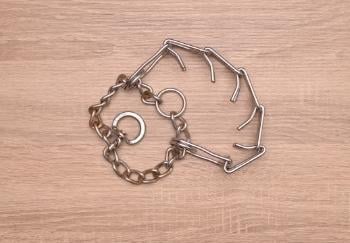 Prong and Choke Collars
Prong and Choke Collars
Prong collars are designed with metal or plastic “prongs” that rest on the dog’s neck. These are aversive type collars that depend on the pressure and pain they inflict on the dog when the dog pulls on their leash. While most of these look quite intimidating with their shiny metal prongs, there are "prong lite" collars that don't look as scary but work using the same aversive methods, such as the Starmark collar.
Choke collars are (typically) metal chains that fit loosely around the dog’s neck but will tighten when the leash is pulled, causing it to choke and constrict around the dog’s neck. Like prong collars, choke chains rely on the pressure and discomfort they inflict on the dog when the dog pulls on their leash to make them stop pulling. Choke collars are especially dangerous in that there is no stopping point for the tightening noose around your dog's neck.
I, and many other pet health, training, and safety organizations, strongly advise against using prong collars and choke chains. They cause pain and discomfort and are unnecessary tools that “teach” using negative reinforcement and positive punishment — a combination that can undermine your relationship with your dog, as well as your training goals. (See this position statement on the use of these aversive tools from The Pet Professional Guild.)
They can also cause neck injuries and breathing problems, as well as multiple types of “training fallout” (including the exact opposite behavior of what you are trying to teach your dog). For your puppy’s sake and yours, just don’t go there. You can read more about why aversive training tools should be avoided in dog training here.
Dog Harnesses
If your dog's collar is only going to be used for ID tags and fashion statements, you'll want to check out our article "Dog Harnesses: Helpful Tools for Loose Leash Walking" to choose the best harness type for your dog. There are lots of different styles of harnesses, from front-attachment to back-attachment and step-in versus over-the-head types. You'll find tips on which is right for your needs and how to properly fit a harness for your dog's body type.
How to Fit a Collar on Your Dog
How Tight Should a Dog Collar Be?
You should be able to fit two fingers snugly between your dog's neck and collar. If you're able to twist two fingers around freely between the collar and their neck, the collar is too loose. Before purchasing a collar, it's helpful to first measure your dog's neck so you're starting with the correct size and then adjust as needed.
Where Should Your Dog's Collar Sit on Their Neck?
Flat collars should sit at the base of your dog's neck. Head collars sit higher up on your dog's neck, with the collar portion sitting just behind your dog's ears. Depending on the collar you're using, follow the manufacturer's instructions for where the collar should be on your dog's neck.
How to Properly Fit a Martingale Collar
Martingale or limited-slip collars should be sized similarly to regular collars, first tightening the collar so two fingers can fit snugly between the collar and your dog's neck. When the smaller loop is tightened from leash pressure, there should still be one to two inches between the two D-rings of the limited-slip portion that's touching your dog's neck. Because these are used for dogs who may slip their collar, it does need to tighten enough that they cannot pull their head back through it.
How to Help Your Puppy Get Used to Wearing a Collar
For a puppy, wearing a collar or harness for the first time probably feels like when we wear an itchy sweater. It can take some time for them to become comfortable wearing something around their neck and body. Some puppies adjust to wearing a collar quickly, while others react much more dramatically.
By taking some time to positively introduce the collar, you can avoid any unneeded stress and teach your puppy that wearing their collar is no big deal! It also helps prevent the problem of a puppy running away and avoiding having their collar put on.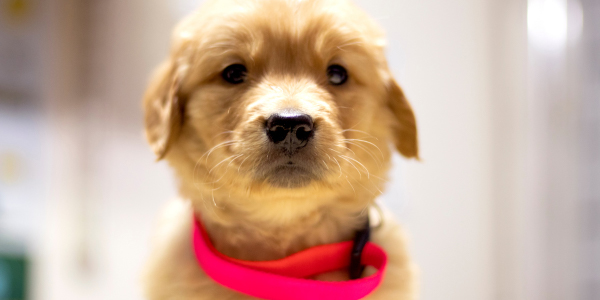
Desensitizing a puppy to having a collar put on and wearing it is very similar to the process seen in the video above for head collars.
- Step One: Show your puppy the collar and then give them a treat. Repeat just showing them the collar, followed by a yummy treat. This is building a positive emotional response to seeing the collar.
- Step Two: Hold the collar out for your puppy for them to sniff. If they touch the collar with their nose, give them a treat. This is called targeting the collar and is increasing their positive emotional response.
- Step Three: With the collar unclipped, gently loop it under your puppy's neck. If your puppy is tolerating this part well, you can clip it closed. If your puppy is showing some nervousness about this step, don't worry about closing the collar around their neck just yet. Give a treat, and then immediately take the collar off. Repeat.
- Step Four: Add duration to wearing the collar. Treat after putting on their collar, but start to wait longer and longer before taking it off.
Over time, your puppy will be so used to wearing their collar that they act like it's not even there. If they are obsessively itching at it or trying to rub it off, consider whether the fit is correct or if the material is causing irritation on their skin. You can redirect their attention to another activity, such as a licking mat or stuffed Toppl toy.
If your puppy is extremely fearful or anxious about having their collar put on, you may need to split the desensitization steps even smaller. Working with a certified dog trainer can help you determine why your puppy is reacting so negatively and walk you through smaller desensitization steps.
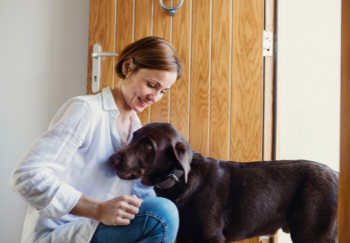 Should Your Dog Wear a Collar Inside?
Should Your Dog Wear a Collar Inside?
Personally, my dogs go naked when they're inside. They are both microchipped and are trained not to door dash, so I feel much safer letting them play freely without a collar on. When we go out for walks, I walk them on a harness, and they both wear their collars with ID tags.
I lean heavily on the side of caution when it comes to wearing collars indoors because of the heartbreaking stories of accidents involving collars that get caught on furniture, latches, or other items and cause strangulation. And if there are multiple dogs in the home that love to play, their teeth and jaws can get stuck in the other dog's collar and result in choking. I've seen this happen, and it's terrifying and also incredibly difficult to untangle.
If your dog needs to wear a collar indoors, whether because they are escape artists, door dashers, or aren't microchipped yet, I highly recommend using a breakaway collar. This type of collar is designed to quickly unsnap when slight pressure is applied, lessening the chance of strangulation if the collar is caught on something or snagged by another dog during play.
If you're crate training your dog or puppy, they shouldn't wear a collar in their crate. If you're uncomfortable with them going naked while in their crate, only use a breakaway collar or at least a lay-flat collar with no loops that has your contact info embroidered on the collar and doesn't rely on tags.
Let us know what collar you like the most for your dog in the comments below!



